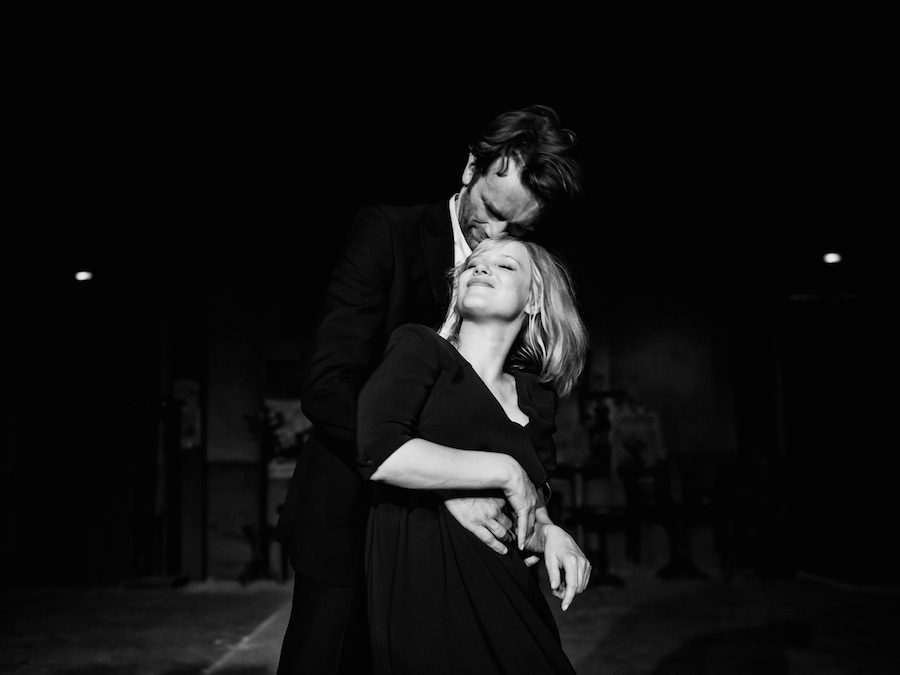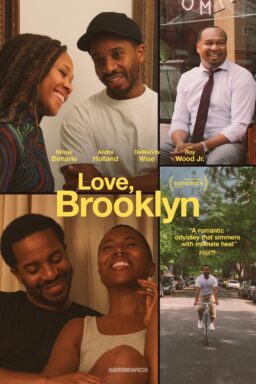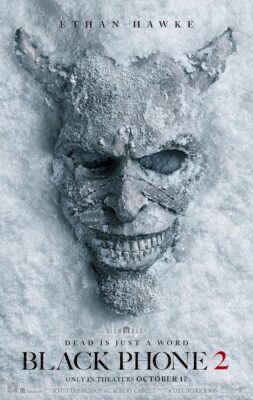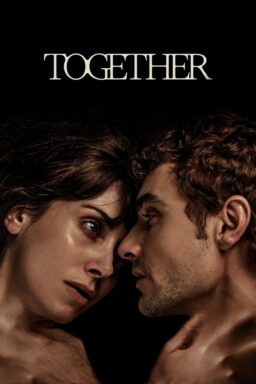“Oh god, how did I get here?” asked Polish filmmaker Paweł Pawlikowski upon winning the Best Foreign Language Film Oscar in 2015 for his masterpiece, “Ida.” “We made a black-and-white film about the need for silence and withdrawal from the world and contemplation, and here we are, at this epicenter of noise and world attention. Fantastic. Life is full of surprises.” It’s entirely fitting that Pawlikowski’s acceptance speech drew attention to the paradoxical nature of his victory, since paradoxes have always played a crucial role in his work. The director’s two recent films—“Ida” and this year’s Oscar contender, “Cold War”—may have been shot in black-and-white, yet there is tremendous contrast within the visual textures onscreen, externalizing Pawlikowski’s philosophy that life exists within a zone comprised of infinitely varied grays. His cinema is undeniably one of contrasts, whether it be between the West and the Polish People’s Republic in “Cold War,” or between the devout novitiate, Ida (played by atheist non-actor Agata Trzebuchowska), and her atheist aunt, Wanda (screen veteran Agata Kulesza), in “Ida.” Upon visiting the former home of her deceased sibling, Wanda stares at the sunlight streaming through the barn window and quips, “That is so Roza: stained glass next to cow s—t.” Later, when Ida, in full nun attire, stands alone in Wanda’s apartment, she resembles the astronaut in “2001: A Space Odyssey,” observing the alien quality of her surroundings.
Just as “Ida” explored the growing bond between two remarkably different women bound by blood, “Cold War” immerses us in the torrid romance of two mismatched souls named after the filmmaker’s own parents, musical director Wiktor (Tomasz Kot) and beguiling young singer Zula (Joanna Kulig). When in Chicago for last month’s Polish Film Festival in America, Pawlikowski spoke with RogerEbert.com about the leading duo of his latest picture, which earned him the Best Director prize in Cannes.
“You have these two creatures—one tall and quiet and slow and dark, the other one blonde and voluptuous and dynamic—and they couldn’t be more of a contrast,” noted Pawlikowski. “I also went for contrast in the visuals. You have scenes that are photographed really brightly next to scenes that are very dark. We didn’t alter too much in the color correction, so contrast was always there onset. The film also cuts from very quiet moments to strong music cues. There is less of this in ‘Ida,’ yet contrast is still present. I suppose that’s what makes stories work as well. I’ve always gravitated toward material that is transcendental but ironic and earthy at the same time. It feels truer to me. I actually talk of ‘paradox’ more than ‘contrast.’ I love the paradoxical nature of existence. There are so many things that go on simultaneously on a very superficial level and on a deep level. All characters are magnificent and awful at the same time. I try not to have any clear-cut good guys or evildoers. Everyone is full of contradictions.”
As tragic as “Ida” and “Cold War” may be at times, there is something hopeful about both pictures. The very thing the characters hold dearest to their hearts—faith in “Ida” or love in “Cold War”—somehow manages to persist despite having every reason to dissolve.
“I’m kind of a lugubrious, melancholy optimist, for sure,” laughed Pawlikowski. “Honesty and beauty have the ability to transcend things. As long as you are honest to yourself and to your story, and as long as you find beauty in what doesn’t seem very beautiful or uplifting, then you’ll be okay. I tend to see that, and my films reflect that, I suppose.”
Ida is able to reclaim her spirituality only after questioning it, enabling her faith to be intuitive rather than rigidly structured. Intuition also happens to be an immensely important part of the director’s creative process.
“People seem to think that I am a very intellectual filmmaker, but I’m actually incredibly naive, though ‘intuitive’ would be a better word for it,” said Pawlikowski. “Of course, I have read a lot of books and dabbled in philosophy, but it wasn’t serious. With this film, critics will throw at me ‘Casablanca’ or Bresson comparisons, and I like the fact that you have a melodrama that feels like life. Life is full of melodrama, especially if you come from a place with a history that creates melodrama. At the same time, I like to have a formal take on it. I don’t think there’s anything wrong with being sentimental or melodramatic, while at the same time trying to find form for the emotions, rather than just let it all hang out. My desire is to be both formal and emotional, and I don’t think there is a contradiction between those two things.”
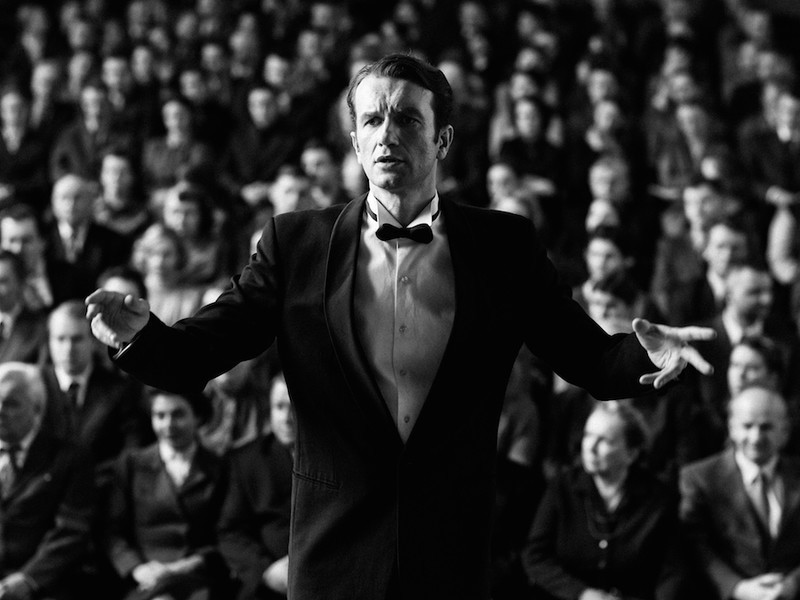
In its tale spanning fifteen years and multiple countries, “Cold War” illustrates how, as a female poet in the film stresses, time doesn’t matter when one is in love. That is the message she intended to convey by writing, “the pendulum kills time,” a line that reverberates metaphorically throughout the film’s last two thirds, as the arc of Wiktor and Zula’s affair is encapsulated in fragmented vignettes bookended by a black screen. Whenever the film cuts to black, it’s as if the pendulum is swinging in front of the camera, taking us to a new extreme point in the couple’s relationship. Initial bliss fades, trust is broken, yet chasms of lost time still fail to dim their need for one another.
“A lot of things were not in the script, including those cuts to black,” admitted Pawlikowski. “I tend to shape films intuitively as I go along. The story—the beginning, middle and end and all the twists and turns in between—remain intact, and all the characters are firmly worked out and established beforehand. But very often during the filming, I give myself the freedom to find better solutions to certain scenes. As far as the use of a black screen is concerned, I realized that it is quite good to leave some time for the audience to take in what they’ve just seen and clean their palate before the next scene begins, because there is a lot to take in. I agonized over the length of each black screen, whether or not they should be half a second longer or shorter. It took a lot of attention to determine this, and I made sure to watch the footage on a big screen, since time passes differently there than it does on an average screen. There was a lot of adjusting necessary in order to get those edits right. The ellipses were always going to be my method of storytelling. I wasn’t going to make a biopic-type of film where you show how A leads to B leads to C and so on. The whole ‘cause and effect’ structure in biopics that span a long period of time is incredibly irritating to me. It seems to suggest that everything in the subject’s life has a clear cause and consequence, when in fact there are so many different causes and consequences that I’d rather just show the tableau through these chunks of time and not explain exactly how we got from here to there. Most people can imagine it for themselves, and if I begin to explain what is left unseen, it would reduce everything. When you start explaining a film, you kill all the poetry, so never explain. Never apologize.”
Even non-religious moviegoers may find themselves having a spiritual experience while watching a Pawlikowski picture. The director’s stripped-down aesthetic offers a reprieve from the visual overstimulation of our modern world, providing us room to quiet our minds and contemplate, courtesy of the extra screen space in “Ida” or the nine cuts to black in “Cold War.” The glorious cinematography from former camera operator Lukasz Zal opts for a 1.37:1 aspect ratio that serves as a rebuke to the wide overstuffed canvas provided by flatscreen televisions. Zal’s ingenious approach to lensing gave the viewer enormous insight into the psychology of Ida, often placing her in the corner of the frame, with the copious headroom seeming to reflect the sprawling uncharted territory she had yet to explore—both in the world and within herself. Pawlikowski affirmed that this was an instinctive choice, and its impact is immeasurable, capturing details that would’ve been obscured by more traditional framing.
“Since I am always working through the image, the mise-en-scène is subject to whatever image I want to create,” said Pawlikowski. “I don’t tell the actors to go do something and then have the camera find some way to cover it. I invent the mise-en-scène in order to produce the most powerful image. It also determines whether or not the camera will move. That sort of image-making causes the overall piece to have a contemplative quality and a certain depth. I’m not looking for pretty images. What interests me are suggestive images that are the right ones for each moment.”
When I interviewed Paul Schrader at the 2016 Toronto International Film Festival, he was on the cusp of making his astonishing new film, “First Reformed,” which has emerged as the contender to beat in this year’s Best Original Screenplay category. Schrader told me about a dinner he had with Pawlikowski a few years prior that provided him with the necessary motivation to make the picture. “He said that if I kept a project at two million dollars, I’d be able to make the exact film I wanted,” Schrader recounted. “As I walked back to my place in New York, I realized that since the budgets of films have come down, I could actually make the spiritual film that I had always been afraid to make because I couldn’t get it financed. So I started writing the script, ‘First Reformed,’ about an ex-military chaplain.” Schrader’s choice of the 1.37:1 aspect ratio is perhaps the film’s most apparent tip of the hat to “Ida.” When I shared this story with Pawlikowski, his elation was infectious.
“He’s such an authority that I’m thrilled our conversation had some kind of impact on him,” said Pawlikowski with a smile. “I could see that he was really buoyed up by ‘Ida’ and its visual take on spiritual themes. Of course, he is so steeped in films like Bresson’s ‘Diary of a Country Priest’ and Bergman’s ‘Winter Light,’ so there were other influences. But ‘Ida’ may have emboldened him because not many modern directors make those sorts of films. When he saw ‘Ida,’ he thought, ‘Okay, maybe I can now finally make ‘First Reformed.’’ Nowadays, anything goes, as long as you raise the money for it, and if it stands out, then it will travel and it will resonate.”

Among the most breathtaking visual details in “Cold War” is a gust of wind that accompanies the very final shot. It is so subtle yet perfectly timed that I couldn’t help asking Pawlikowski whether or not it was accidental.
“In order to give us just the right smidgen of a waft, we were working with an out-of-control propeller,” recalled Pawlikowski. “It was a nightmare because it f—ked up every take, and we were losing light quickly. There was only one take where everything went more or less correctly. Everything in the film was completely engineered. There were no accidents. You can’t rely on accidents like that. Sometimes you just have to wait and wait for it to all come together. Everything is on the brink of catastrophe all the time. If we didn’t get that shot, then we’d end up with nothing because the actors had to leave the next day. Lukasz is a good collaborator in terms of thinking with me on the image-making. He’s a very close collaborator who is really skillful with light and facilitates things rather than being an obstacle to them, which is what often happens with DPs who take themselves too seriously. When I work with Lukasz, I know that he is on my team and on my side.”
The final shot of “Ida” contrasts with the static framing that characterized the rest of the picture, as a handheld camera conveys the unsteadiness of Ida’s reclaimed identity. This visual approach foreshadows the camera movement utilized throughout “Cold War,” particularly when regarding Zula. Like Wanda, she is a fascinating character prone to making bold decisions, including one that has proven to define her life. When prodded by Wiktor on why she nearly killed her father, she explains, “He mistook me for my mother, and I used a knife to show him the difference.” In a way, this character could be an extension of the pop singer Kulig played in “Ida,” though for “Cold War,” Pawlikowski wanted her to emulate the restrained, sardonic allure of Lauren Bacall. It’s impossible to take your eyes off of her, especially in the rousing sequence where the camera follows her onto the dance floor as “Rock Around the Clock” blares on the soundtrack.
“We moved the camera only when the film called for it,” said Pawlikowski. “Zula is so fidgety and she has so much energy that it would be crazy not to go with it. Plus music creates a certain energy, so all these things made it pretty clear that the camera shouldn’t remain still. Filmmakers sometimes move the camera just to show that they are directing, but for me, I don’t believe the camera should move unless there is a reason to do so. It is not the camera moving so much as the characters, because their actions are what motivates the camera to not be fixed in one place.”
In fact, “Cold War” boasts one of the year’s great soundtracks, paralleling the evolution of Wiktor and Zula’s romance with an assortment of tunes ranging from Polish roots music and folk ensembles to jazz variations on the same themes.
“I found a folk ensemble called Mazowsze, which is the inspiration for the one that you see in the film,” said Pawlikowski. “I call them Mazurek, which is basically camouflage for Mazowsze. I had to call them something else in order to give myself narrative freedom, because I didn’t actually tell the story of the real folk ensemble. I also used three tunes from their repertoire that first appear as basic, primitive folk songs, before being performed as ‘fakelore’ by a state ensemble, and then later on, they appear as jazz. One of the songs, ‘Oberek opoczynski,’ becomes a bebop number when we first cut to Paris, and the characters dance to it. It’s the same song that the woman plays on the accordion at the beginning of the film. The song Zula sings in the recording studio is also heard at the very beginning when Wiktor listens to the recording of the performances they’ve captured. So I have three tunes that emerge all the time in different shapes and they are kind of like glue in the film, especially since the story is very fragmented. I pilfered the official orchestrated and choreographed numbers of this real folk ensemble, then dismantled them and made them source music. Then finally, I asked a friend of mine, who is a jazz arranger, to arrange them for a romantic, jazzy rendition as well as a bebop quintet.”
An early scene in “Ida” of Trzebuchowska exiting a car in order to kneel before a religious relic is mirrored in “Cold War,” though in this case, it is one of Wiktor’s cohorts seeking a place to urinate before stumbling upon the remains of a church. Pawlikowski brings the film full circle by having Wiktor and Zula return to this same location at the end, as hinted by the “Gatsby”-esque motif of eyes painted on a wall.
“That was an Orthodox church in southeastern Poland where a lot of Ukrainians used to live,” said Pawlikowski. “It had been destroyed since the second world war. We painted on those frescos, but the space itself has a slightly eerie, transcendental quality about it.”

Speaking of piercing eyes, few are as adept at cutting through BS as those belonging to Kulesza. In an essay included in “Ida”’s official Blu-ray booklet, my old college chum Sara Freeman likens Kulesza to a “Polish Elizabeth Taylor,” and those same words could easily apply to her performance as Irena, Wiktor’s perceptive associate in “Cold War.” She can sense his infatuation with Zula perhaps before even he does, dubbing her “the Heart one.”
“Agata’s a good friend, and she’s got a bit of that edge in her real character, give or take,” said Pawlikowski. “She is a really sharp actress—very intelligent, very witty, but as a human being, she has got those qualities too, so when I came up with the character of Irena, I immediately knew that it would be her playing the role. In ‘Ida,’ she is much more messed up because Wanda, her character, did horrible things. She has blood on her hands, whereas in ‘Cold War,’ she’s like a monument to what I love most about Poland. Irena has the noble, nonconformist attributes that characterize a certain type of Poland—not sentimental but profoundly good. She’ll go under if need be for her principles, and she has a kind of acerbic sense of humor where she tells it like it is. She wants to do good, to construct things like folk ensembles, and she doesn’t think about it in political terms. She really believes that she is doing something valuable. She’ll put her neck on the line and I love that. I also love her sense of humor. She’s not embittered, she’s not bellyaching, she’s not blaming anyone. She’s just taking it on the chest. We need more people like her in Poland. I have an aunt like that, and my dad was a bit like that too.”
Part of what makes “Ida” such a haunting experience is how it unearths things that have been buried over time, not least of all its heroine’s sexuality. Even if she chooses not to explore it further, at least she knows that it’s there. Like Ida, Pawlikowski was a young adult when he learned of his Jewish relatives who were killed during the Holocaust. His film’s portrayal of crimes committed by Poles while under German occupation caused the film to be blacklisted in its own country. This occurred because of a law passed in March that outlawed any suggestion that “the Polish nation” was “responsible or co-responsible for Nazi crimes committed by the Third Reich,” despite there being significant evidence to the contrary. “Any film which does not simplify reality will have problems today [in Poland],” Pawlikowski said when “Cold War” premiered at Cannes. “Poland is going through a very ideological time with the new right-wing government which is reinterpreting everything based on two very simple criteria — ‘Back then was absolute evil, and now everything is great. We are a noble people, it was the terrible communists [who did those things] and not us, it was the Martians.’ This is not a time for nuance.” The current rise in anti-Semitism was only intensified when Russian president Vladimir Putin suggested that Jews may have been responsible for his government’s hacking of the 2016 U.S. election. Under immense pressure from allies, Poland backpedaled on the severity of its law in June, eliminating criminal penalties for violators.
“We thankfully haven’t yet gotten to the point where we are living in a totalitarian situation,” Pawlikowski told me. “The government can give subsidies to things, but they can’t resort to censorship—though who knows what will happen a few elections down the line. By the way, in Poland, we recently had elections which did not go badly for the liberal urban dwellers, yet the push against art and against a freedom of imagination in place of simplistic storytelling is huge now. People in Poland want to reduce our country’s history to a very simple narrative where we are basically victims and always try to be on the right side of things. What I try to show in my work is not the opposite of that, but rather, how complicated and paradoxical life can be, as we discussed earlier. I want the ability to go against the grain of these simplistic narratives, and even some leftist narratives, which are incredibly simplistic and politically correct beyond all measure. I’m basically trying to preserve this freedom in inventing art where you’re not thinking ideologically, where you are just thinking intuitively about the truth of life like in the old great works of Chekov or Shakespeare. We have to keep that a free zone, and it’s difficult not only because of idealogical pressures, but also commercial pressures, which force you to tell simplistic, moralistic tales with goodies and baddies and where everybody’s reduced to some kind of puppet. Elections won’t change that struggle. This latest one has just given us some breathing space, but it’s not a time for nuance anywhere, and I’m not sure it’s any better here in the states. You have better institutions, but it’s a troubled time no matter where you go. On one hand, art is meant to show the complexity and paradoxical nature of characters, of situations and of the world itself, but it is also meant to draw attention to what is timeless and transcendent—which is not the state-sponsored story. It is something much more important than that, and it’s not related to one particular nation or ethnic group. Art should tap into something that is universal.”
Whereas the label of “faith-based film” in America has often been tied to small-minded propaganda, “Ida” is a spiritual work from a Catholic director that rises to the level of high art. There is nothing pushy or preachy in Pawlikowski’s method of opening our minds and hearts to a realm existing beyond the material world. Even his simple choice of compressing the frame on either side somehow makes us more in awe of the towering imagery.
“I’m just creating space for spirituality rather than driving home a statement,” affirmed Pawlikowski. “I want to create a space where you are open to the vertical dimension, but also open to how fragile and contradictory we are on earth. Let’s not kid ourselves that we are better than that.”

